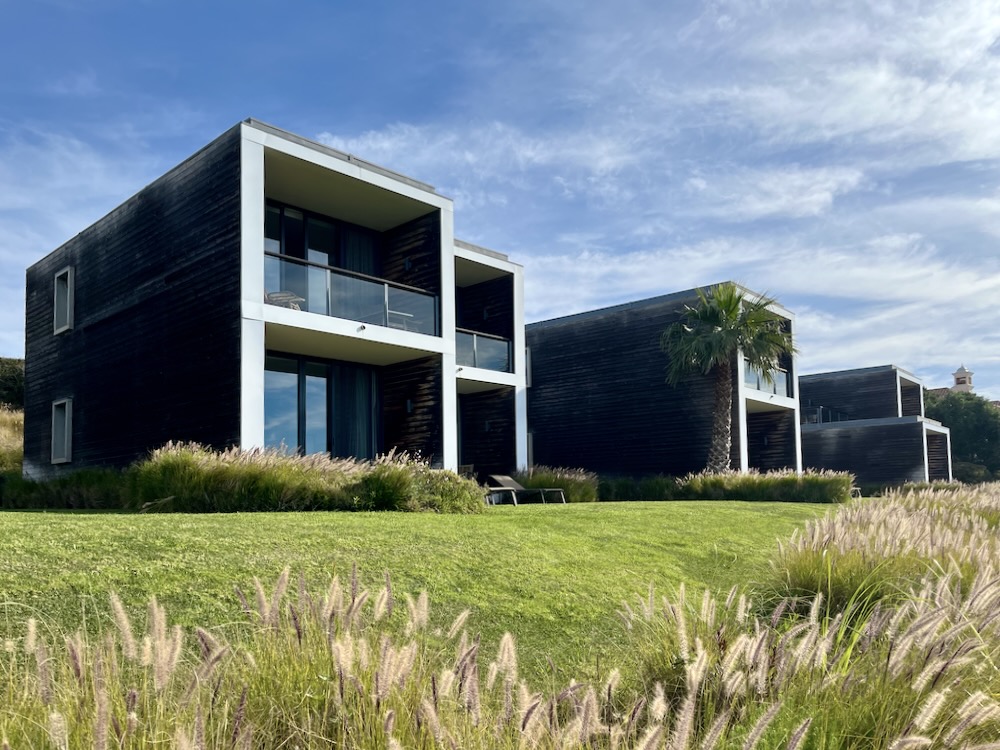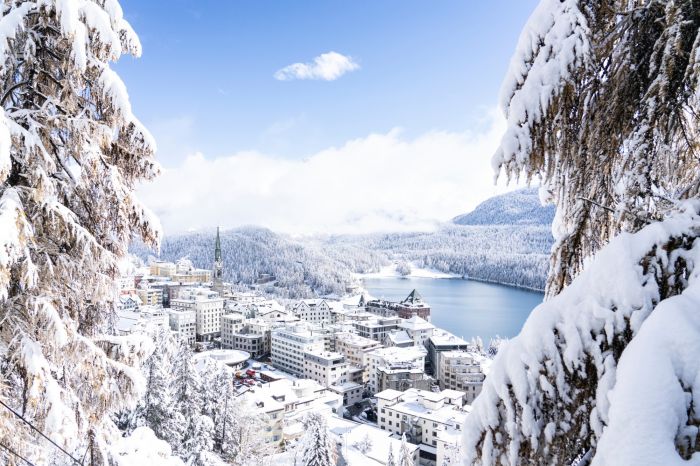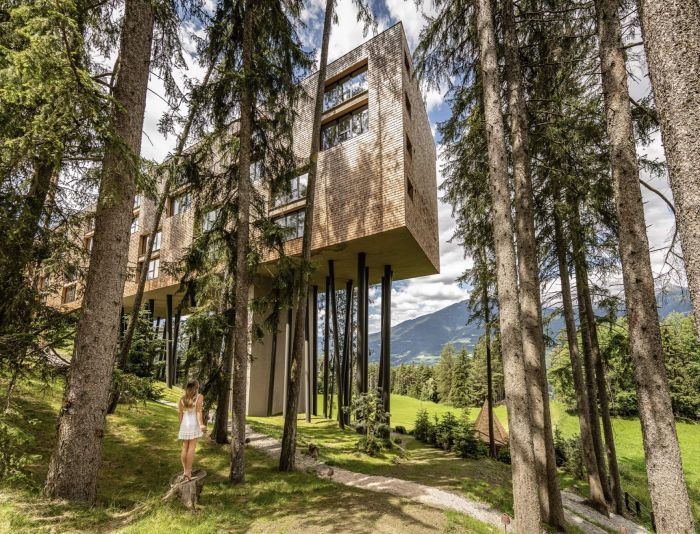
Photo Courtesy of St. Regis Mexico City
The St. Regis Mexico City is the seventeenth St. Regis Hotel in the world and the first St. Regis to be built in a major city in Latin America. It is 31 stories and contains 189 guestrooms, 35 suites and 108 private residences.
 It was the Emperor's wish to directly link his imperial residence, Chapultepec Palace, with the National Palace in the City Center. And from one of the St. Regis terraces, Chapultepec Palace can be seen rising from the surrounding Chapultepec Park, the largest city park in Latin America.
It was the Emperor's wish to directly link his imperial residence, Chapultepec Palace, with the National Palace in the City Center. And from one of the St. Regis terraces, Chapultepec Palace can be seen rising from the surrounding Chapultepec Park, the largest city park in Latin America.
Right outside the St. Regis is a traffic roundabout in whose center is a large fountain with the sculpture of Diana the Huntress. The architect Vicente Mendiola and the sculptor Juan Olaguíbel were commissioned in 1942 to build the fountain, whose subject was Diana, the Roman goddess of hunting. But for this fountain, it was decided that this goddess, instead of hunting animals, would hunt the stars of the northern skies. Thus, the formal name of this dramatic fountain is, the Northern Star Shooter.
 It is in this historic area, with the street practicality of the Emperor combined with the hopes of the star shooter, that the St. Regis arises, 495 feet high, currently making it the second tallest building on the Paseo De La Reforma and the ninth tallest in Mexico City. As seen from its exterior, the hotel is a curved, triangular form with an elegant, delicately proportioned wall of clear glass and white aluminum.
It is in this historic area, with the street practicality of the Emperor combined with the hopes of the star shooter, that the St. Regis arises, 495 feet high, currently making it the second tallest building on the Paseo De La Reforma and the ninth tallest in Mexico City. As seen from its exterior, the hotel is a curved, triangular form with an elegant, delicately proportioned wall of clear glass and white aluminum.
"It's a functionally diverse building, full of life," said Pelli recently. "It incorporates beautiful, creative spaces for individuals with relaxing open areas whose sole purposes are for public enjoyment." I remembered this quote as I traveled recently to the luxury hotel. I wanted to see how the diverse culture of the city joined with the high-end urban, United States brand of the St. Regis.
 I have been to three St. Regis properties before (in Aspen, Punta Mita and New York) and the uniformity of brand elegance always impresses me. The guests actually do have personal butlers and even at 4:00 a.m. they will bring Capuccino, or anything else you might want or need.
I have been to three St. Regis properties before (in Aspen, Punta Mita and New York) and the uniformity of brand elegance always impresses me. The guests actually do have personal butlers and even at 4:00 a.m. they will bring Capuccino, or anything else you might want or need.
The time quoted for in-room dining arrival is always correct or a little early. Flowers are changed daily, there are no odd bugs in the flowers, and the fruit sent to the room had been recently washed. Also, here, as in other St. Regis locations, the respect for the local culture displayed itself through the exceptional interior designs and pieces of art around the lobbies, meeting areas and in the rooms. Yabu Pushelberg, one of the most famous names in interior design, did the interiors for the St. Regis Mexico City.
 "We broke down all of the public spaces into a series of more intimate rooms to create a feeling of a regal home rather than corporate space," said Glenn Pushelberg, recently. "Our design intent was to really capture the essence of Mexico while complimenting the iconic architecture and the floor-to-ceiling glass exteriors."
"We broke down all of the public spaces into a series of more intimate rooms to create a feeling of a regal home rather than corporate space," said Glenn Pushelberg, recently. "Our design intent was to really capture the essence of Mexico while complimenting the iconic architecture and the floor-to-ceiling glass exteriors."
Silver-plate and green are used in guestrooms to accent the natural light, and all furniture pieces are designed especially for The St. Regis Mexico City. Nepal Sober carpets, handcrafted bronze Mexican elliptical cluster walls and doors, English Sicomoro floors, and decorative screens are just a few of the interior elements that add to the colorful, yet peaceful atmospheres.
 Candelabra lighting fixtures by Sharon Marston, for example, compliment the elegant St. Regis style, often inspired by nature. Personally, I have never seen lighting fixtures like these in any ballroom or conference room. They looked like large iridescent, clouds on the ceiling with tiny white lights embedded in them. Further, and still under Yabu Pushelberg's direction, Moss and Lam created the primary walls of the hotel, each unique and inspired by natural shapes like flowers, stars and leaves.
Candelabra lighting fixtures by Sharon Marston, for example, compliment the elegant St. Regis style, often inspired by nature. Personally, I have never seen lighting fixtures like these in any ballroom or conference room. They looked like large iridescent, clouds on the ceiling with tiny white lights embedded in them. Further, and still under Yabu Pushelberg's direction, Moss and Lam created the primary walls of the hotel, each unique and inspired by natural shapes like flowers, stars and leaves.
 More art pieces are also sprinkled throughout the hotel and include a Ricardo Regazzoni sculpture at the main entrance of the hotel; several paintings by Mexican artist Gabriel Macotela in the Atrium and in the Decanter Room; and an intricately designed 3-D flower wall sculpture designed by artist Helen Amy Murray made with leather by Moore & Gilesin for the hotel's signature restaurant, Diana Restaurant. Also, there is a significant hand-painted mural by Pablo Weisz at the King Cole Bar.
More art pieces are also sprinkled throughout the hotel and include a Ricardo Regazzoni sculpture at the main entrance of the hotel; several paintings by Mexican artist Gabriel Macotela in the Atrium and in the Decanter Room; and an intricately designed 3-D flower wall sculpture designed by artist Helen Amy Murray made with leather by Moore & Gilesin for the hotel's signature restaurant, Diana Restaurant. Also, there is a significant hand-painted mural by Pablo Weisz at the King Cole Bar.
 This bar honors a long standing tradition begun at the original St. Regis in New York, where the original Bloody Mary was created. At each St. Regis, the bartender creates its own signature Bloody Mary, and here in Mexico City, this was no exception. The signature cocktail is called the Sangrita Maria, and though it looks like a Bloody Mary, one taste will tell you it is something much more subtle and spicy.
This bar honors a long standing tradition begun at the original St. Regis in New York, where the original Bloody Mary was created. At each St. Regis, the bartender creates its own signature Bloody Mary, and here in Mexico City, this was no exception. The signature cocktail is called the Sangrita Maria, and though it looks like a Bloody Mary, one taste will tell you it is something much more subtle and spicy.
This concoction mixes Mezcal, sangrita and a bold dash of Pasilla chile puree. In addition to the Diana Restaurant in the hotel and the Decanter Room, a large room full of crystal decanters usually reserved for special, more formal dining, is the Jean-Georges Steak House that is set to open later in 2011.
 Finally, the St. Regis Mexico City has the Remède Spa. Located on the 16th floor, the spa offers seven treatment rooms and spa lounges with city views as well as a Juice and Tea Bar. I enjoyed the Azteca Regenerating Facial with oxygen treatment. It was something so needed and wanted and quite cooling.
Finally, the St. Regis Mexico City has the Remède Spa. Located on the 16th floor, the spa offers seven treatment rooms and spa lounges with city views as well as a Juice and Tea Bar. I enjoyed the Azteca Regenerating Facial with oxygen treatment. It was something so needed and wanted and quite cooling.
The St. Regis Mexico City, even though a significant high-end hotel, also has the earmarks of a substantial urban resort in the middle of a highly cultured, historic city. Inside the St. Regis, it is quiet and peaceful; outside the business of life, in a city of 20 million, moves quickly on.














